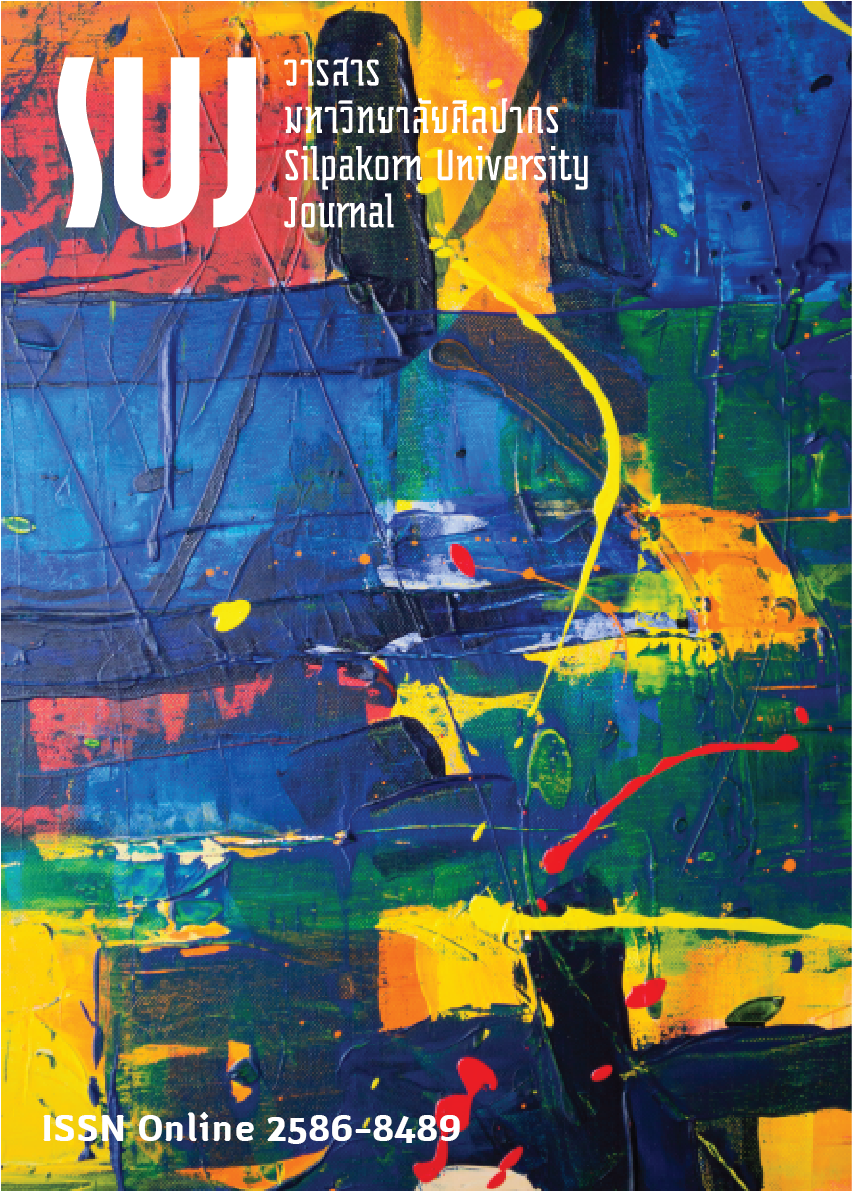การศึกษาภาพยนตร์ดิสโทเปียกับการผสมผสานระหว่างตระกูลภาพยนตร์ (The study of Dystopian film with the mix of film genres)
Main Article Content
Abstract
บทความครั้งนี้มุ่งเน้นการศึกษาที่มา ความหมาย และความสำคัญของดิสโทเปีย ซึ่งเป็นสังคมที่มีความโกลาหล ความวุ่นวาย ความไม่เสมอภาค และไร้ซึ่งความชอบธรรม โดยมีสาเหตุมาจากการวางอำนาจของผู้ปกครองที่ฝักใฝ่ระบอบทุนนิยม และแสวงหานโยบายรูปแบบต่าง ๆ เพื่อลิดรอนสิทธิ์ของประชาชนให้อยู่ภายใต้การปกครองอย่างเบ็ดเสร็จ อีกทั้งการครอบงำ และการปลูกฝังทัศนคติ การบังคับให้เข้าร่วมบูชาลัทธิใหม่โดยปราศจากความรู้สึกผิดชอบใด ๆ อย่างไรก็ตาม การศึกษาสังคมดิสโทเปียพบได้ในบริบทงานที่ถ่ายทอดเรื่องเล่าผ่านงานศิลปะหลายแขนง โดยหนึ่งในงานที่ได้รับความนิยม คือบริบทงานภาพยนตร์ ดังนั้นบทความวิชาการครั้งนี้จึงต้องการอธิบายสังคมดิสโทเปียในเชิงภาพยนตร์ เนื่องจากภาพยนตร์ดิสโทเปียมิได้จัดอยู่ในขอบข่ายตระกูลภาพยนตร์ตามแนวคิดและทฤษฎีตระกูลภาพยนตร์ (genre) อันนำไปสู่การค้นพบองค์ความรู้ใหม่ที่เชื่อมโยงกับความเป็นภาพยนตร์ดิสโทเปียในแง่มุมการผสมกันระหว่างตระกูลภาพยนตร์ กระนั้นการศึกษาครั้งนี้เผยให้เห็นถึงขนบ (convention) และความเป็นภาพยนตร์ดิสโทเปีย (Dystopian film) ภายใต้การข้ามสายระหว่างตระกูลภาพยนตร์วิทยาศาสตร์ และตระกูลย่อยคัลท์ ด้วยเหตุนี้การหล่อหลอมระหว่างตระกูลภาพยนตร์จึงนำไปสู่การค้นพบ “สูตร” (formula) ภายในคุณลักษณะของภาพยนตร์ดิสโทเปีย
This article investigates dystopian societies presented in films by focusing on the background to dystopia, its definition, and importance. “Dystopian society” refers to a society which is filled with chaos, social division, and injustice. Dystopian society stems from the demands of capitalist rulers who seek ways to deprive people’s rights. In addition, this type of rulers dominates people’s ideas, brainwashes, and forces them to join a new cult. Among different forms of fiction in which the presentations of dystopian society have been explored, film is a popular form. Therefore, through a cinematic perspective, this article attempts to analyze the dystopian society which has never been included in any genres of film or film theories. Consequently, this study discovers that the convention of dystopian films are resulted from the integration between the convention of the science fiction film and of sub-genre of the cult film.
Downloads
Article Details

This work is licensed under a Creative Commons Attribution-NonCommercial-NoDerivatives 4.0 International License.
References
Baccolini, R. (2004). The Persistence of Hope In Dystopian Science Fiction. Cambridge: Cambridge University Press.
Butler, S. (2009). Erewhon. Auckland: The Floating Press.
Boonyakarnjawa, Suttichai. (1990). An Analytical Study of American Dystopia Science Fiction From 1950 to 1972 A.D. (การศึกษาเชิงวิเคราะห์นิยายวิทยาศาสตร์อเมริกันแนวดิสโทเปียในช่วง ค.ศ.1950 ถึง ค.ศ.1972). Master’s dissertation, Chulalongkorn University, Bangkok, Thailand.
Chotudompan, Suradech. (2015). Literature: Literature of Dystopia Bangkok Creative Writing Workshop 4th (Literature: วรรณกรรมดิสโทเปีย Bangkok Creative Writing Workshop 4th). [Online]. Retrieved July 14, 2015 from https://www.youtube.com/watch?v=TQOiUAS9XPQ
Chotudompan, Suradech. (2015). PachaThai Special Report: Origins and Influence Literature Utopia and Dystopia (ประชาไทรายงานพิเศษ: ต้นกำเนิด และอิทธิพล วรรณกรรมยูโทเปียและดิสโทเปีย). [Online]. Retrieved July 8, 2015 from https://prachatai.com/journal/2015/07/60233
Dermajian, L. M. (2016). The Age of Dystopia: One Genre, Our Fear Our Future. Newcastle upon Tyne: Cambridge Scholars Press.
Fitting, P. (2009). A Short History of Utopian Studies. Science Fiction Studies, 36(1): 126.
Franklin, H. B. (1998). America as Science Fiction. Oxford: Oxford University Press.
Gendler, A. (2016). How to Recognize a Dystopia. [Online]. Retrieved November 15, 2016 from https://www.youtube.com/watch?v=6a6kbU88wu0
Green, A. W. (1966). Sir Francis Bacon. Woodbrige: Twayne Publishing.
Huang, H. (2017). Distinguishing Pattern of Utopia and Dystopia, East and West. Master’s dissertation, University of South Florida, Florida, United State.
Jameson, F. (2007). Archaeologies of The Future: The Desire Called Utopia and Other Science Fiction. London: Verso Press.
Jayanama, Soravis. (2012). From Revolution to Globalization (จากการปฏิวัติถึงโลกาภิวัตน์). Bangkok: Khledthai Publishing.
Jayanama, Soravis. (2012). From Revolution to The World of Globalization: Basic Knowledge of Critical World Politics Through Film (จากการปฏิวัติถึงโลกาภิวัตน์: ความรู้เบื้องต้นการเมืองโลกเชิงวิพากษ์ผ่านสื่อภาพยนตร์). Bangkok: Siam Pritat.
Koetdi, Kritsada. (2004). Film History: The Study of 10 Film Genres (ประวัติศาสตร์ภาพยนตร์: การศึกษาว่าด้วย 10 ตระกูลภาพยนตร์สำคัญ) (3rd ed.). Bangkok: Printing Word.
Parisi, T. (1999). Civilization and Its Discontent: An Anthropology for the Future. Woodbrige: Twayne Publishing.
Sandra, D. (2003). Science Fiction at The Movie Astonish me. Melbourne: ATOM publishing.
Schwab, Klaus. (2018). The Fourth Industrial Revolution (การปฏิวัติอุตสาหกรรมครั้งที่สี่). Bangkok: Amarin Printing.
Seltzer, M. (1998). Serial Killers: Death and Life In America’s Wound Culture. New York: Routledge.
Sher, G. (2010). Utilitarianism. Indianapolis: Hackett Publishing Company.
Sookprecha, Tomorn. (2018). How Do We Know If We Are Living in Dystopia (จะรู้ได้อย่างไรเรากำลังอาศัยอยู่ในดิสโทเปียหรือเปล่า). [Online]. Retrieved September 19, 2019 from https://www.the101.world/were-already-living-in-a-dystopian-universe
Tierney, D. (2014). Mapping Cult Cinema in Latin American Film Culture. Cinema Journal, 54(1): 29-130.
Voltaire. (1759). Candide. edited by Sousa, N. D. (2016). n.p.
Zipes, J. (2003). Foreword: Utopia, Dystopia And The Quest of Hope. In Utopian And Dystopian Writing For Children And Young Adults. New York: Routledge.


